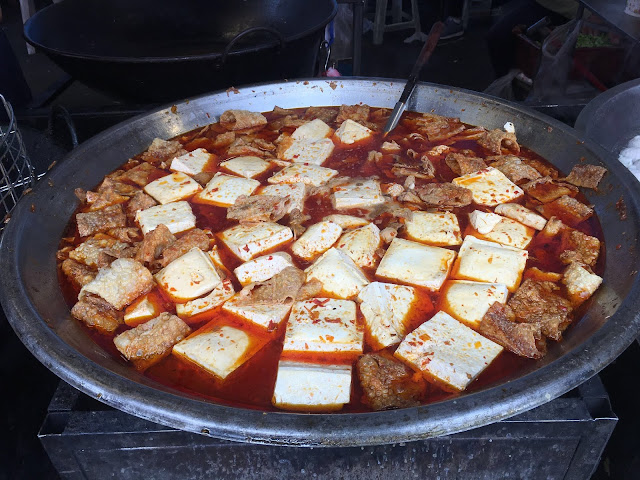Taiwan has a long history of cultivating and importing soybeans and soy products. Soybeans were first cultivated in Northeast Asia at least 2700 years ago. Since at least 1647, Taiwan has been importing soybeans. Currently, 97% of all consumed beans in Taiwan are imported from America.
Formosan beans, native to Taiwan, also grow wild in Indonesia and Hawaii. During the Japanese occupation, soybeans were primarily grown for oil, which was used in lamps and cooking. Soybeans are the world's number one source of vegetable oil and the sixth largest food crop globally. In Taiwan, the 50,000 hectares of soybeans grown are primarily used to fix nitrogen in the soil.
Soybeans have higher protein, calcium, vitamin C, vitamin B1, and vitamin B9 content compared to other major crops. Soy products are often considered healthier options. However, consuming excessive amounts of soy can lead to the formation of kidney stones due to the presence of oxalic acid. Unfermented soy products like tofu and soy milk contain phytic acid, which can inhibit the absorption of iron, zinc, calcium, and copper. The isoflavones in soy can also hinder iodine absorption, potentially leading to hypothyroidism. On the positive side, soy consumption has been associated with anti-cancer effects due to the presence of phytoestrogens.
Soybean seeds contain around 18-19% oil. The oil is extracted by cracking the beans, adjusting their moisture content, and extracting the oil using commercial hexane. The oil is then refined. The material left after extraction is known as soymeal, which contains about 50% protein and is used as animal feed. Soy can also be used to make flour, which contains 50% protein, 5% fiber, and is gluten-free. Baked goods made with soy flour have a rich color and dense texture. Soy can be used as a substitute for eggs, milk, margarine, yogurt, cheese, and meat. It can also be used to make nut butter. Roasted and ground soybeans can serve as a caffeine-free substitute for coffee.
See also: Soy Sauce Factory
There are various types of soy products, including soy milk (豆漿, dòujiāng), tofu (豆腐, dòufu), dried tofu (豆干, dougan), and bean-curd pudding (豆花, douhua). Tofu, also known as bean curd, has been consumed in China for over 2000 years. The Shenkeng District in New Taipei City is considered the capital of stinky tofu (臭豆腐, choudoufu).
Unpressed fresh tofu, also known as soft tofu, silken tofu, or douhua, is gelled soy milk without being cut or pressed to remove liquids. Impressed extra soft tofu is made by mixing soy milk with seawater or saline water, resulting in soft and loose curds. Silken tofu (滑豆腐, huádòufu) is gelled with gypsum and has high moisture content, making it suitable as a substitute for dairy products and eggs.
 Picture source: https://images.app.goo.gl/3TuogevPh1PZxxP37
Picture source: https://images.app.goo.gl/3TuogevPh1PZxxP37
Bean-curd pudding (豆花, douhua) is similar to silken tofu and is usually eaten a few hours after being made. Some variations are made from black soybeans, resulting in a more gelatinous texture and grayish color. Firm tofu (老豆腐, lǎodòufu) is dried and pressed tofu with high moisture content, while extra firm tofu (豆干, dòugān) has the least amount of moisture among fresh tofu varieties.
There are also many processed tofu products. Pickled tofu (豆腐乳, dòufurǔ), also known as fermented tofu, is air-dried and slowly fermented with the help of airborne bacteria. Stinky tofu (臭豆腐, chòudòufu) is a soft tofu that undergoes fermentation in a vegetable and fish brine, resulting in its distinct pungent smell.
Frozen tofu (冰豆腐, bīngdòufu) is made from soft tofu, and the formation of ice crystals creates layered cavities. It has reduced water content, resulting in a harder and gummier texture with a yellowish color. Tofu skin is produced by boiling soy milk, forming a skin of protein and lipids on the surface. It can be collected and dried into yellowish sheets known as soy milk skin (腐皮, fǔpí) or dried into tofu skin (腐竹, fǔzhú), which can be shaped into various forms.
Soy pulp (豆腐渣, dòufuzhā) is the fiber, protein, and starch leftover after extracting soy milk from soaked beans. It can be used as an ingredient in vegetarian burgers or ice creams but is mostly used as animal feed. Soy milk (豆Soybeans are also an important ingredient in soy sauce (醬油). Soy sauce brewing began approximately 2500 years ago during the Han Dynasty in China and was introduced to Taiwan in 1649. WanChuang Soy Sauce (丸莊醬油) Factory, established in 1909, is one of the soy sauce factories where you can observe the traditional brewing method.













0 komentarze:
Post a Comment